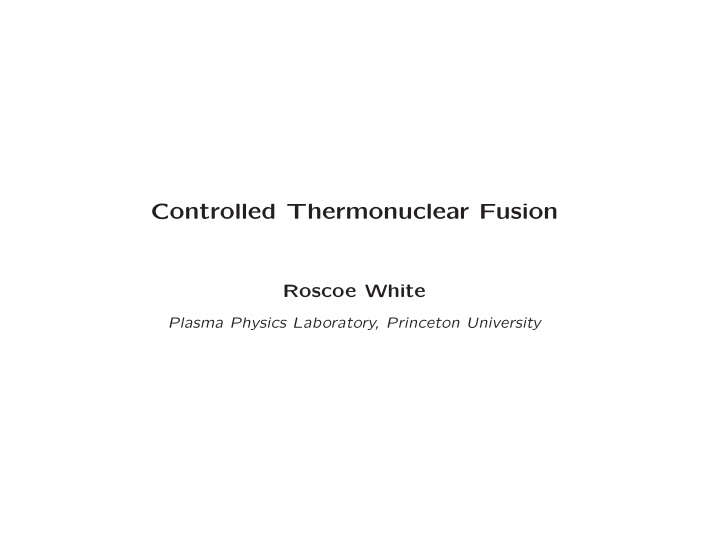



Controlled Thermonuclear Fusion Roscoe White Plasma Physics Laboratory, Princeton University
The promise of cheap clean energy Consistently twenty years off, for the last 60 years Research began at Princeton with project Matterhorn in 1951 In 1950 Sakharov and Tamm sketched a tokamak design. Declassified 1958, Geneva conference on Atomic Energy D + T → H 4 nTτ E > 3 × 10 21 keV s/m 3 e (3 . 5 MeV ) + n (14 . 1 Mev )
Much progress made since 1 KeV plasma in Kurchatov T-3 1968 1994 at PPPL in Princeton and at JET in Abingdon fusion power out equalled roughly half of the heating power in. Fusion power in KW has increased more rapidly than computer speed. Princeton was in the 90’s the hottest place in the solar system, 200 million degrees, more than 20 times the interior of the sun, with a plasma volume of cubic meters. Tile wall at 1000 degrees, as on shuttle. Stable discharges have run for minutes, Heating is no problem with neutral beams, But need all three, Temperature, density, confinement time, implies large size.
Nuclear Physics- came to US with Oppenheimer, Bethe, Wheeler, Fermi Chicago PhDs of Enrico Fermi, 1941-1950’s Owen Chamberlain - A-bomb - Berkeley - Nobel Prize for anti-protons Goeffery Chew - Scattering Matrix, Berkeley Mildred Dresselhaus - Carbon nanotubes, MIT Jerome Friedman - MIT - Nobel Prize for discovery of quarks Marvin Goldberger - π meson decay, Princeton University Tsung Dao Lee - Columbia - Nobel Prize for parity violation James Rainwater - A-bomb, Columbia - Nobel Prize asymm. nuclei Marshall Rosenbluth - H-bomb, Thermonuclear fusion- Princeton IAS Arthur Rosenfeld - Berkeley , development of bubble chamber Jack Steinberger - Columbia - Nobel Prize for muon neutrino Sam Treiman - cosmic rays, weak interactions, Princeton University Paul and I are grandsons of Enrico Fermi
Why has it taken so long? • The initial expectation was that fusion could be solved in 20 years • The first 20 years were experiments with small systems, incapable of obtaining good confinement or high temperatures. • Once the tokamak was discovered (1968) and temperatures increased, confinement improved. • Stable equilibrium was obtained and understood, Grad-Shafranov • The magnetic field containing the plasma, when the plasma density and temperature are significant, begins to thrash and kink. • With good confinement and high densities, losses, instabilities were discovered, analyzed theoretically (occasionally first!), and defeated. • A long list - Kink mode, Sawtooth, Fishbone, Ripple, Tearing, TAE • A course in fusion theory proceeds from equilibrium analysis through the list of instabilities and finally to transport in the stable system.
The 20 billion dollar international reactor size next step - ITER Tokamak under construction outside Aix en Provence, in Cadarache, where France makes its nuclear submarine engines. Should produce net energy, maybe a factor of 10 over input. BUT Too costly, does not extrapolate to an economic reactor. Fuel cost is negligible, the cost of power hinges entirely on the cost and lifetime of the reactor.
Stellarators offer a steady state plasma but are more complex Tokamaks are axially symmetric, but the poloidal field is produced by transformer induced plasma current, pulsed, not steady state. First high energy plasmas were achieved with tokamaks in USSR. Initial attempts at Princeton were with stellarators and leaked, only low temperatures. But with new computer simulation capabilities designs can overcome the leakage. Wendelstein 7X - construction in Greifswald, Germany, PLASMA 2015.
A new idea that might work, leading to smaller, better, cheaper 80 keV 80 keV NBI Plasma Plasma T < < 16 keV 16 keV turbulent + thermo−conduction D Zi diffusive energy D + and particle losses D Recycling Li PFC Plasma column heated by 80 KeV Neutral beam injection. High recycling as in present devices, T small at edge, large gradient. A pumping wall, utilizing liquid lithium and making the wall invisible to the plasma, giving small temperature gradient, low turbulence. Some experiments in Princeton, Intensly pursued in China. Success woud dramatically reduce size and cost of a reactor.
The Future • The US program is slow, with small participation in ITER • Unfortunately the long time scale of the research does not help • Time scale for progress is longer than congressional election periods. • Costs of ITER threaten to destroy the domestic program • Intense effort under way in China, Korea, Japan and now India with plans to build a demonstration reactor • A small ignition device IGNITOR is a proposed collaboration between Italy and Russia, but problems in Ukraine give it an uncertain future. • Princeton admits about 7 grad students per year, but only some of them work on fusion, we are barely keeping up an educated cadre of professionals who know fusion theory. • It is essential to reduce the size and cost of a reactor
Recommend
More recommend